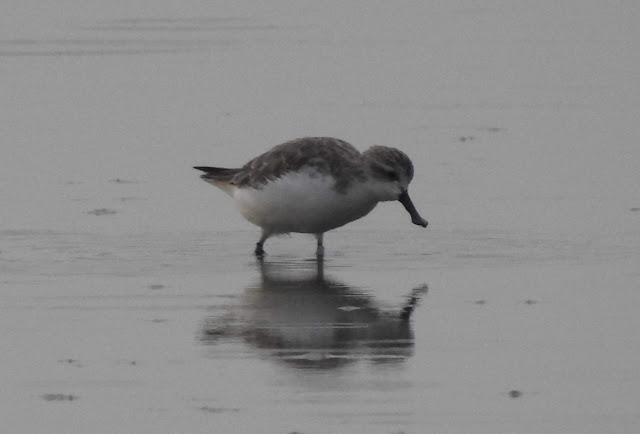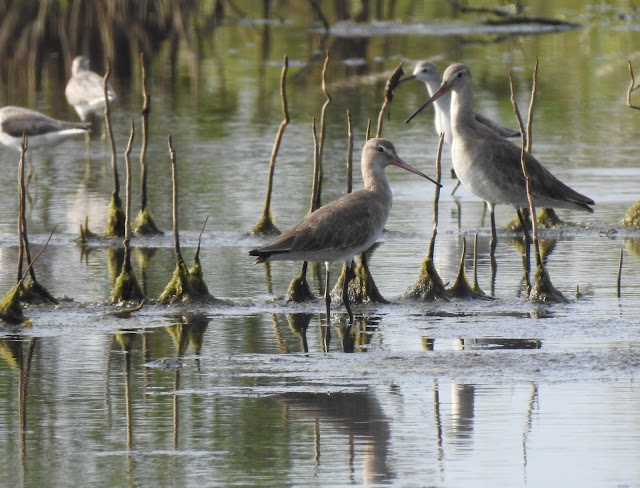 |
| Waders at Khok Kam |
Today I hired a guide and driver from a Thai birding company
– Wildbirdeco. Their website is here –
http://www.wildbirdeco.net/ The company specialise in birding, nature photography and wildlife trips and tours, originally and still in Thailand but now over south east Asia. I originally thought the price was a little steep for a ½ day tour, and for one person, it kinda was but it would have been much cheaper had I had any friends….. [So for 6 people the total charge would have been very little more….]
http://www.wildbirdeco.net/ The company specialise in birding, nature photography and wildlife trips and tours, originally and still in Thailand but now over south east Asia. I originally thought the price was a little steep for a ½ day tour, and for one person, it kinda was but it would have been much cheaper had I had any friends….. [So for 6 people the total charge would have been very little more….]
My trip was a common one with a single species target in
mind – the Spoonbill Sandpiper. There was also the promise of other wader
species. An early start was needed and my van, English speaking guide and
driver were there to meet me when I stumbled out of my cheap Khao San Road area
hotel at 5-50am in the morning….The drive down south towards the coast was
surprisingly busy and my heart sunk a little when it started or perhaps
continued raining. After a stop for coffee we were soon at the salt pans / mud
flats and our local guide – the non English speaking - Suchart Daengpayon (Tee)
was there to meet us at Khok Kam.
 |
| my guide, Tee. |
Khok Kam is an area of salt pans and mud that is well known
to birders! Despite it being largely mud it does have a beauty to it,
especially in the early morning light, before it bakes under a hot Thai sky.
And there were birds; lots of birds.
 |
| Khok Kam - early morning skies |
But first the bird I had especially come to see…the Spoon
billed Sandpiper.
 |
| Spoon billed Sandpiper - lifer! |
 |
| Spoon billed Sandpiper - lifer! |
From the Bird Conservation Society of Thailand [BCST] [https://www.bcst.or.th/about-us/ ];
Spoon-billed
Sandpiper (Calidris pygmaea) is the most
threatened shorebird on the East Asian-Australasian Flyway, with perhaps as few
as 200 breeding pairs remaining, having undergone a dramatic decline during the
past two decades, partly as a result of loss of habitat on the flyway. Like
many migratory shorebirds found in Thailand, the Spoon-billed Sandpiper breeds
on the Russian tundra and twice a year makes a hazardous migration along the
coasts of east Asia. About 10 Spoon-billed Sandpipers are recorded in the Inner
Gulf of Thailand each year with Pak Thale-Laem Phak Bia in Phetchaburi province
having the highest annual records. This bird is quite site faithful as shown by
the fact that birds flagged and numbered on the breeding grounds have been
recorded at the same sites in the Inner Gulf of Thailand on successive years.
From the Saving the
Spoon billed Sandpiper https://www.saving-spoon-billed-sandpiper.com/ ;
Studies on the
breeding grounds indicate that the severe population decline in the 2000s
was driven by high mortality of young birds – the proportion of fledged birds
that returned to the breeding grounds was very low, just 0.05 birds recruited
per adult per year. In contrast, adult survival (76% p.a.) and productivity
(about 0.6 young fledge per pair annually) were within the bounds of what would
be expected for a small arctic-breeding wader species.
 |
| Spoonie in breeding grounds. |
The species’ long-term
decline is likely the result of habitat loss and degradation,
particularly the reclamation of inter-tidal staging sites in the Yellow
Sea, but trapping on the wintering grounds appears to be a key reason for the
acceleration in the rate of decline. Some evidence suggests that most young
birds remain on their non-breeding grounds for their first two years, and are
therefore likely to be more vulnerable to trapping.
Since 2009, action has
been undertaken throughout the flyway by a wide range of people and
organisations working in partnership to halt the decline. There are encouraging
signs that conservation measures are reducing the impacts of some threats and
bolstering the population but there is also the continuation of some key
threats and the emergence of new ones. There remains a great deal of work to
do. The most important and challenging aspect of which is maintaining and
protecting habitat at key sites, particularly stopover sites in the Yellow Sea.
At least one key stopover site remains unknown. The first site where
spoon-billed sandpipers are normally observed in the autumn, the Jiangsu coast
of China, is too far from the breeding grounds to be the first stopover site
indicating a site in Russia remains to be found. Similarly, only a portion of
the population can be found during breeding and wintering seasons indicating
there are also breeding and wintering sites yet to be found.
The ultimate goal of
spoon-billed sandpiper conservation is a secure future for the species.
Conservationists have set an ambitious but achievable aim to not only halt the
decline by 2025, but increase the population by 50% (to 300 pairs) over that
same period.
 |
| #05 surrounded by Red necked Stints |
‘Lime 05’ is the most well known among several
flagged Spoon-billed Sandpipers that have been recorded in Thailand. It is a
female bird that was ringed on 20 June 2013 in the vicinity of Meinypil’gyno
Village, Anadyr District, just south of the Arctic Circle in Chukotka
Autonomous Area, Far East Russia. She was then observed and photographed on her
wintering grounds at Khok Kham, Samut Sakhon Province, Inner Gulf of Thailand
on 30 November 2013 after a long-distance migration covering over 7,500 km from
Far East Russia. She remained there until at least 6 March 2014 and since then,
has continued to come back to the same area every winter.
It was a privilege to see such a critically endangered bird and it was definitely one that i would have needed help to find.
 |
| from left to right - Lesser Sand Plover, Broad billed Sandpiper, Red necked Stint |
Curlew Sandpipers, Red Knots, Great Knots, Common Greenshank, Marsh Sandpiper, Red necked Stints were all seen and these are all birds that are still relatively easy to see in Australia.
 |
| Marsh Sandpiper |
 |
| Common Greenshank |
Black tailed Godwits can also be added to the above list.
 |
| Black tailed Godwits |
As, perhaps, can Wood Sandpiper.
 |
| Wood Sandpiper |
 |
| Wood Sandpiper |
I also got good numbers of Broad billed Sandpipers; an uncommon species in Oz.
 |
| Broad billed Sandpipers |
 |
| Broad billed Sandpiper |
Long toed Stints, a rarity in Australia, were seen a few times.
 |
| Long toed Stint |
 |
| Long toed Stint |
Redshank, another very rare species in an Australian context, were seen here quite commonly.
 |
| Redshank |
Other resident species included White headed Stilt, Little, Intermediate and Great Egrets, Grey Heron, Little [Striated] Heron.
 |
| White headed Stilt |
Terns included Little, Whiskered and Caspian while there were a few non breeding Brown headed Gulls.
 |
| Brown headed Gulls |
Migratory Yellow Wagtails were active in the salt marsh.
 |
| Yellow Wagtail |
 |
| Some guys take bird photography a little more seriously than I do... |
All in all a great morning's birding!
 |
| Add caption |


No comments:
Post a Comment